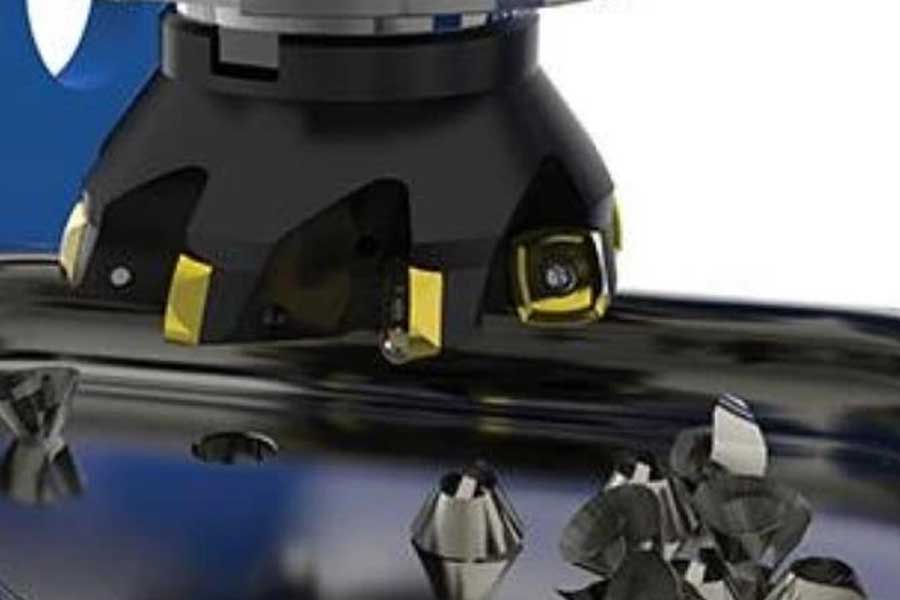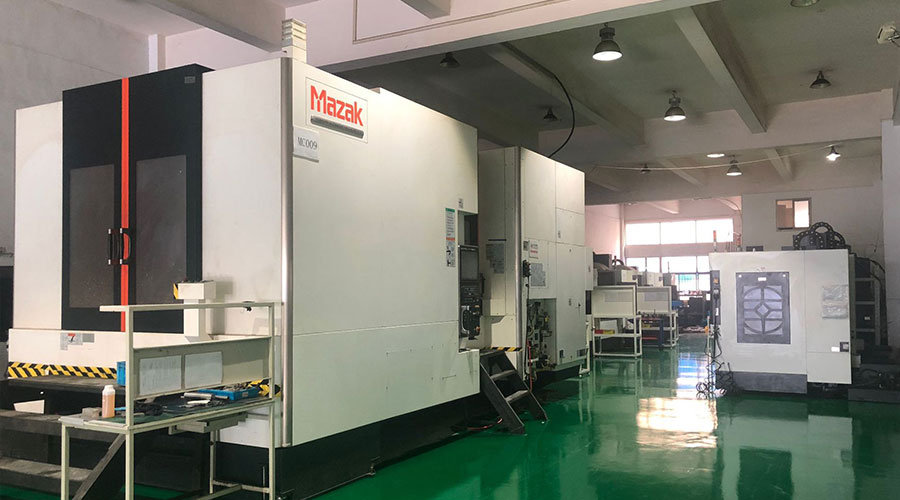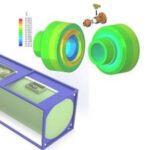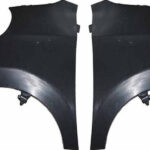Titanium alloys and aluminum alloys are similar in the following respects: Both metals are used to make aircraft structural components, in which case the components may require 90% of the material to be ground off before the parts are completed. Many factories hope that these metals have more in common.
John Palmer, global aerospace manager at tool manufacturer Stellram, said many of these factories actually have more titanium processing capabilities than they realize. Many valuable techniques for efficiently machining titanium are not difficult to adopt, but few shops use all the techniques available for efficient milling of this metal. So he consulted the manufacturer about ways to improve the milling performance of various aerospace alloys (including titanium alloys). Titanium processing is not necessarily difficult, but the entire processing process must be considered, because any element may hinder the effectiveness of the entire processing process.
Stability is the key. When the tool touches the workpiece, it closes into a circle. The tool, tool holder, spindle, column, guide rail, table, fixture, and workpiece are all part of the circle and part of the required stability. Other important considerations include the pressure and volume of the coolant, and the method of delivery of the coolant. In this article, the editor of Xianji.com has compiled the following 10 techniques in order to realize the potential of those processes that have the potential to efficiently process titanium. I hope they will be helpful to everyone.
1. Maintain low radial engagement
Table of Contents
One of the key challenges of titanium is heat dissipation. In this kind of metal, the heat generated during processing is relatively small and is discharged with the chips. Compared with processing other metals, the heat during titanium processing enters the tool more. Due to this effect, the choice of radial engagement determines the choice of the metal surface speed.
Full grooving means that 180 degree engagement requires a relatively low surface speed. But reducing the radial engagement reduces the time for the cutting edge to generate heat and allows the cutting edge more time to cool down before entering the material in the next round. Therefore, as the radial engagement decreases, the surface speed can be increased while maintaining the temperature of the cutting point. For finishing, the milling process includes a very small arc of contact with a sharp, polished cutting edge and a high surface speed and minimal feed per tooth can achieve extraordinary results.
2. Increase the number of grooves
Commonly used end mills have four or six grooves. In titanium alloys, this may be too little. The more effective number of flutes can be 10 or more.
Increasing the number of grooves can compensate for the need for low feed per tooth. In many applications, the groove spacing of a 10-slot tool is too small, which is not conducive to chip clearance. However, productive milling of titanium has favored low radial depths. The resulting small chips can be opened freely to use high-slot end mills to increase productivity.
3. From thick to thin
“Climbing milling” is a common term for this concept. In other words, do not feed the milling cutter, so that the edge passes through the material in the same direction as the cutter feed. This machining method called “conventional milling” causes the chips to begin to thin and thicken. When the tool impacts the material, the frictional force generates heat before the material starts to shear from the base material. Thin chips cannot absorb and discharge the generated heat, and the heat enters the tool. Then, at the exit where the chips are thicker, the increased cutting pressure makes chip sticking a danger.
Climbing milling or chip formation from thick to thin starts when the cutting edge enters the excess material and exits on the machined surface. During side milling, the tool tries to “crawl” over the material, forming a thick chip at the entrance to maximize heat absorption, and a thin chip at the exit to prevent chip adhesion.
Contour milling requires careful inspection of the tool path to ensure that the tool continues to enter the excess material and exit the machined surface in this way. Achieving this in a complex process is not always as simple as just keeping the materials correct.
4. Arc in
In titanium and other metals, the useful life of the tool is lost due to drastic changes in force. The worst moments often occur when the tool enters the material. Direct feed (which is the case with almost all standard tool paths) produces an effect similar to hitting the cutting edge with a hammer.
Gently slide in. To do this, create a tool path that arcs the tool into the material instead of inputting it as a straight line. In rough milling to fine milling, the entry arc of the tool path should follow the same direction as the tool rotation (clockwise or counterclockwise). The arc entry path allows the cutting force to be gradually increased, preventing gripping or tool instability. Heat generation and chip generation also gradually increase until the tool is fully operational.
5. End on the chamfer
A drastic change in force also occurs at the exit of the tool. It is as useful as thick and thin cutting (tip 3). The problem with this method is that when the tool reaches the end of the hole and starts to remove the metal, thick and thin cutting suddenly stops. Sudden changes will produce similar sudden changes in force, impacting the tool, and may damage the surface of the part. In order to prevent such a sudden transition, take precautions, first mill a 45-degree chamfer at the end of the hole, so that the tool can see its radial depth of cut gradually decrease (see Figure 5).
6. Rely on secondary pressure relief
The sharp cutting edge can minimize the cutting force of titanium, but the cutting edge must also be strong enough to resist cutting pressure. The design of the secondary pressure relief tool, in which the first frontal area of the cutting edge resists the force, and then the second area falls off to increase the gap, achieving these two goals. Secondary pressure relief is very common in tools, but it is especially true in titanium alloys. Experimenting with tools with different secondary pressure relief designs may reveal surprising changes in cutting performance or tool life.

7. Change the axial depth
At the cutting depth, oxidation and chemical reactions affect the tool. If the tool is reused at the same depth, early damage may occur at this point. When performing continuous axial cuts, this damaged area of the tool may cause work hardening and lines on parts that are unacceptable for aerospace components, which means that this effect on the surface may require the tool to be replaced in advance. To prevent this from happening, protect the tool by changing the axial cutting depth of each weld bead, and distribute the problem area to different points along the groove. In the turning process, similar results can be obtained by taper turning for the first pass and parallel turning for the next pass, thereby preventing the depth of the cut.
8. Limit the axial depth around elongated features
The 8:1 ratio is very useful when milling thin-walled and unsupported features in titanium alloys. To avoid deflection of the bag walls, mill these walls in successive axial stages instead of milling the entire wall depth in one pass with an end mill. Specifically, the axial cutting depth of each step should not be greater than 8 times the wall thickness left after these milling passes. For example, if the wall thickness is 0.1 inches, the axial cutting depth of adjacent milling passes should not exceed 0.8 inches.
Despite the depth limitation, it is still possible to use this rule so that productive milling is still possible. To do this, the machine is thin-walled, so that a blank envelope is left on the surrounding wall, making the last function 3 or 4 times thicker. For example, if the thickness of the wall is kept at 0.3 inches, the 8:1 rule allows an axial depth of 2.4 inches. After these passes, the thick wall is machined to the final size with a lighter axial depth.
9. Choose a tool much smaller than a pocket
Due to the extent to which the tool absorbs heat in the titanium, the tool needs clearance to allow cooling. When milling small grooves, the tool diameter should not exceed 70% of the groove diameter (or similar size). If the gap is less than this value, it is possible to isolate the tool from the coolant and trap the chips, otherwise these chips may take away at least part of the heat.
The 70% rule can also be applied to tools that mill on the top of the surface. In this case, the width of the feature should be 70% of the tool diameter. The tool is offset by 10% to encourage the creation of chips from thick to thin.
10. Get clues from tool steel
High-speed feed milling cutter is a tool concept developed for machining tool steel in the mold industry in recent years and has been used for machining titanium. High-feed milling cutters require a lighter axial cutting depth, but when operating at this lighter cutting depth, the allowable feed rate of the tool is higher than that of a milling cutter with a more traditional design.
The reason is that the chips become thinner. The key to a high-feed rolling mill is a large radius curve inserted into its cutting edge. This radius causes the chips to form a large contact area that extends to the edge. Due to the resulting thinning, an axial cut depth of 0.040 inches may only produce a chip thickness of about 0.008 inches. This thin chip overcomes the low feed per tooth normally required in this metal. The thinning of the chip has opened the way for the improvement of the programming feed rate.
Link to this article:Ten tips for titanium alloy processing technology: I wish you an increase in the productivity of milling titanium alloys
Reprint Statement: If there are no special instructions, all articles on this site are original. Please indicate the source for reprinting:https://www.cncmachiningptj.com/,thanks!
 3, 4 and 5-axis precision CNC machining services for aluminum machining, beryllium, carbon steel, magnesium, titanium machining, Inconel, platinum, superalloy, acetal, polycarbonate, fiberglass, graphite and wood. Capable of machining parts up to 98 in. turning dia. and +/-0.001 in. straightness tolerance. Processes include milling, turning, drilling, boring, threading, tapping, forming, knurling, counterboring, countersinking, reaming and laser cutting. Secondary services such as assembly, centerless grinding, heat treating, plating and welding. Prototype and low to high volume production offered with maximum 50,000 units. Suitable for fluid power, pneumatics, hydraulics and valve applications. Serves the aerospace, aircraft, military, medical and defense industries.PTJ will strategize with you to provide the most cost-effective services to help you reach your target,Welcome to Contact us ( [email protected] ) directly for your new project.
3, 4 and 5-axis precision CNC machining services for aluminum machining, beryllium, carbon steel, magnesium, titanium machining, Inconel, platinum, superalloy, acetal, polycarbonate, fiberglass, graphite and wood. Capable of machining parts up to 98 in. turning dia. and +/-0.001 in. straightness tolerance. Processes include milling, turning, drilling, boring, threading, tapping, forming, knurling, counterboring, countersinking, reaming and laser cutting. Secondary services such as assembly, centerless grinding, heat treating, plating and welding. Prototype and low to high volume production offered with maximum 50,000 units. Suitable for fluid power, pneumatics, hydraulics and valve applications. Serves the aerospace, aircraft, military, medical and defense industries.PTJ will strategize with you to provide the most cost-effective services to help you reach your target,Welcome to Contact us ( [email protected] ) directly for your new project.
Link to this article:Ten tips for titanium alloy processing technology: I wish you an increase in the productivity of milling titanium alloys
Reprint Statement: If there are no special instructions, all articles on this site are original. Please indicate the source for reprinting.:Cnc Machining,Thank!^^








